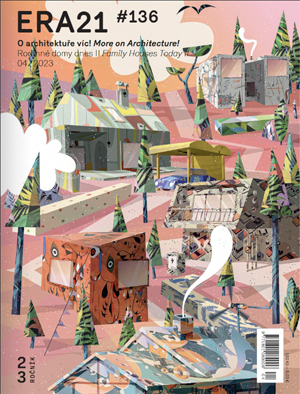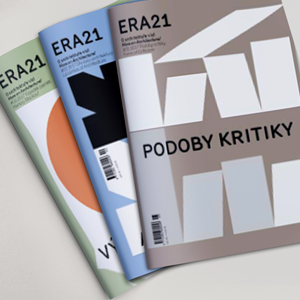| editorial |
Leisure Landscapes » entire article |
|
| news | ||
| intro |
Walking on Water » The Floating Piers was the first project Christo realised after his partner Jeanne-Claude's death. Their very specific kind of environmental art was a combination of diligent preparation, often spanning decades and including public discussions, and a careful search for a concrete form. This preparatory stage is represented here by selected artworks, but it is actually a work of art in its own right—art of agreement, of dialogue with the environment, of the joy of seeing a known thing with fresh eyes. It is a temporary landscape, too. |
|
| starting points |
Leisure Landscapes » Is the reconsideration of the contemporary approach to recreational landscapes actually necessary? Or is there something more hidden behind this reasoning? Maybe our current demands on landscape and expectations of inhabitability reflect a new kind of complex sustainability—economic and environmental. However, the process of searching for this sustainability reveals potential interpretations of our landscapes' different characters and uses. When considering the establishment of microregion identities and economic networks, a synergy of solutions becomes essential. |
|
| completed project |
Water at Every Step. Nature Trail Around Olšina Pond » In the former military area of Boletice, close to the Lipno water reservoir, a nature trail was built around the Olšina pond in 2020. The pond dates back to the 15th century and boasts an area of 138 hectares with an elevation of 731 meters above sea level. It is one of the highest ponds in Bohemia. Tourists taking the new wooden boardwalk through the wetlands, woodlands and moorlands can feel the presence of water every step of the way. Educational panels and entertainment objects accompany the trail. |
|
| interview |
Emotional Landscape. Jan Mach and Jan Vondrák Interviewed by Ida Chuchlíková » Jan Mach and Jan Vondrák, founders of Mjölk architecture office in Liberec, are very much influenced by the landscape around the foothills of the Jizerské Mountains and the Ještěd Ridge. They attended university there, and they still live and work there today. Their long term focus on architectural interventions in nature was predetermined by the surrounding setting. As a result, they built several lookout structures on nearby hilltops. In our interview, we discussed the ways in which architecture should enter open landscapes, how we should react when these structures cause controversy, and how generosity and joy are essential parts of the job. |
|
| completed project |
Watchmen on Guard. Lookouts Above Rokytnice nad Jizerou » The Stráž hill, called Guard by the locals, is the highest peak of a woody ridge just south of Rokytnice nad Jizerou. In the old days, smoke signals were sent from the hilltop if enemy forces invaded the country. Kozákov hill and other watch hills would send the signal further inland. Today the town of Rokytnice has different watchmen. The council originally planned to build a traditional lookout tower, but the shape of the ridge proved unsuitable for this purpose. A series of smaller architectural interventions on existing rocky outcrops in the woods was chosen instead. The lightweight structures of timber and steel are placed in different environments, some offering scenic views to distant peaks, others an opportunity to observe life in the forest canopy close at hand. The names and shapes of the lookouts—the Fox, the Bear, the Sheep, and the Miner—come from the four patrons on the Rokytnice coat of arms, representing the four original villages making up the town. |
|
| competition |
Vision for Milada. International Landscape, Urban, and Architectural Design Competition » The area around the city of Most, North Bohemia, changed rapidly during the 19th and 20th century. A densely populated agricultural landscape gave way to industrialization. A brown coal mine was opened between Ústí nad Labem and Teplice in the 1970s, growing gradually, until it swallowed nine square kilometers of landscape and six whole villages. Mining stopped twenty-four years later and a landscape recultivation project reclaimed the mine basin for the new Lake Milada. In order to fi nd an optimal, feasible, and sustainable way to adapt the lakeside areas for sport and recreation of the surrounding towns’ and cities’ residents, an international landscape, urban and architectural design competition was organized. All planned interventions aim to preserve and enhance the existing unique natural character of the lake’s surrounding landscape. |
|
| theory and practice |
Ecosystem Services and Suburban Landscapes » Ecosystem services represent a fast-growing tool for describing and evaluating the benefits people obtain from nature. The interdisciplinary approach encompases natural sciences, economics, sociology or environmental psychology, even pursuing monetary valuation of the benefits, which is something that conventional economics continues to struggle with. Ecosystem services can play a key role in planning, creating or protecting urban and suburban landscapes. |
|
| interview |
Landscape Architecture Is the Future. Jenny Osuldsen and Peter Zöch Interviewed by Hana Lesáková » Based on the intersection of architecture and several neighboring professions, the Norwegian studio Snøhetta proves again and again that an interdisciplinary approach leads to high quality results. In this respect they are pioneers, spearheading change and leading by example. On the opening night of their Arctic Nordic Alpine exhibition in Jaroslav Fragner Gallery in Prague, we spoke to Jenny Osuldsen, landscape architect and partner in the office, and Peter Zöch, communications manager in the Innsbruck branch. |
|
| completed project |
High Ground. Tourist Trail Meeting Points in Nordkette Mountains near Innsbruck » Ten rather inconspicuous meeting points are strung on a three-kilometer-long tourist trail meandering through the mountainside above Innsbruck, North Tyrol. Various types of benches and platforms gently nudge the hikers to stop, take a minute and enjoy the dramatic vistas. Naturally weathering materials such as local larch wood and corten steel were chosen to make the interventions blend in seamlessly with the landscape. Weathering steel is also used for the local avalanche barriers, propped up all around the steep slopes. Quotes from Austrian philosopher Ludwig Wittgenstein are inscribed on the new meeting points. |
|
| completed project |
Past Landscape. Tourist Trail from Repurposed Railway Track » Like a thin ribbon, winding through the undulating landscape of the sub-Vosges hills, is the new tourist and bike trail connecting the villages of Rosheim and Saint-Nabor in Alsace, France. Reclaimed from an abandoned railway, originally transporting goods and passengers to and from the local quarries, the 11 km trail is divided into five stages and dotted with corten steel pavilions and lookouts. Occasionally, rusty train tracks preserved in the pavement draw attention to the original train stop locations. |
|
| project |
Tiempo de Silencio. Design of the North-West Part of Metropolitan Forest Madrid » The north-west section of the new Madrid Metropolitan Forest is designed by LOLA Landscape Architects, Volterra Ecosystems consulting and agroforestry company, and local architects Burgos & Garrido. Winning the fall 2020 competition issued by the city council, their proposal envisions a parametric mosaic of different forests accommodating both recreation and farming. Madrid Metropolitan Forest will improve climate, biodiversity and air quality, offer new and accessible recreation space and advance the city towards its goal of carbon neutrality. |
|
| idea |
Traces on the Landscape » Scattered around a grassy hillock, flat corten benches and luminous tube pieces form curious twisting shapes. Is it architecture, land art, or an open-air museum? A bit of each, actually. The landscape intervention invites visitors to the Celtic Iron Age fort Castro Toiriz in Galicia, Spain. Although the site is yet to be excavated, a magnetic survey using ground-penetrating radar has shown the layout of the existing structures, still underground. The new pieces seemingly floating above ground replicate the remains that lie hidden several meters below. The installation is part of a musealisation, landscape intervention and enhancement project financed by the Spanish government, providing access and information systems for eighteen Galician-Roman settlements in the province of Pontevedra. |
|
| trends | ||
| annex |
Surface Flatness Control in Building Façades |
|
| annex |
Saving Water in the Bathroom |
|
| annex |
Cladding on Blanka Tunnel Ventilation Shaft in Prague |


ERA21 vydává ERA Média, s. r. o. |
|
|
Phone: +420 530 500 801 E-mail: redakce@era21.cz |
|
| WEBdesign Kangaroo group, a.s. |